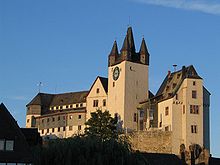This article needs editing to comply with Wikipedia's Manual of Style. (January 2023) |




The County of Diez (also known as Dietz, German: Grafschaft Diez) was a county of the Holy Roman Empire, centred around Grafenschloss in Diez, located in Lahngau (in modern German states of Hesse and Rhineland-Palatinate). The county is first recorded in 1073, likely formed from the lands of the Conradine dynasty after their relocation to Swabia. The Counts of Diez gained prominence in the late twelfth century as strong supporters of the Hohenstaufen dynasty, earning it the nickname "Golden County."
However, following the downfall of the Hohenstaufens in 1254, the influence of the Counts of Diez waned. In 1302, the County of Weilnau was carved out of Diez to establish a separate branch, based at Altweilnau Castle. Over time, the remaining County of Diez gradually lost territories through pawning to settle debts. By 1388, upon the death of the last count, the County was inherited by Adolf I, Count of Nassau-Siegen.